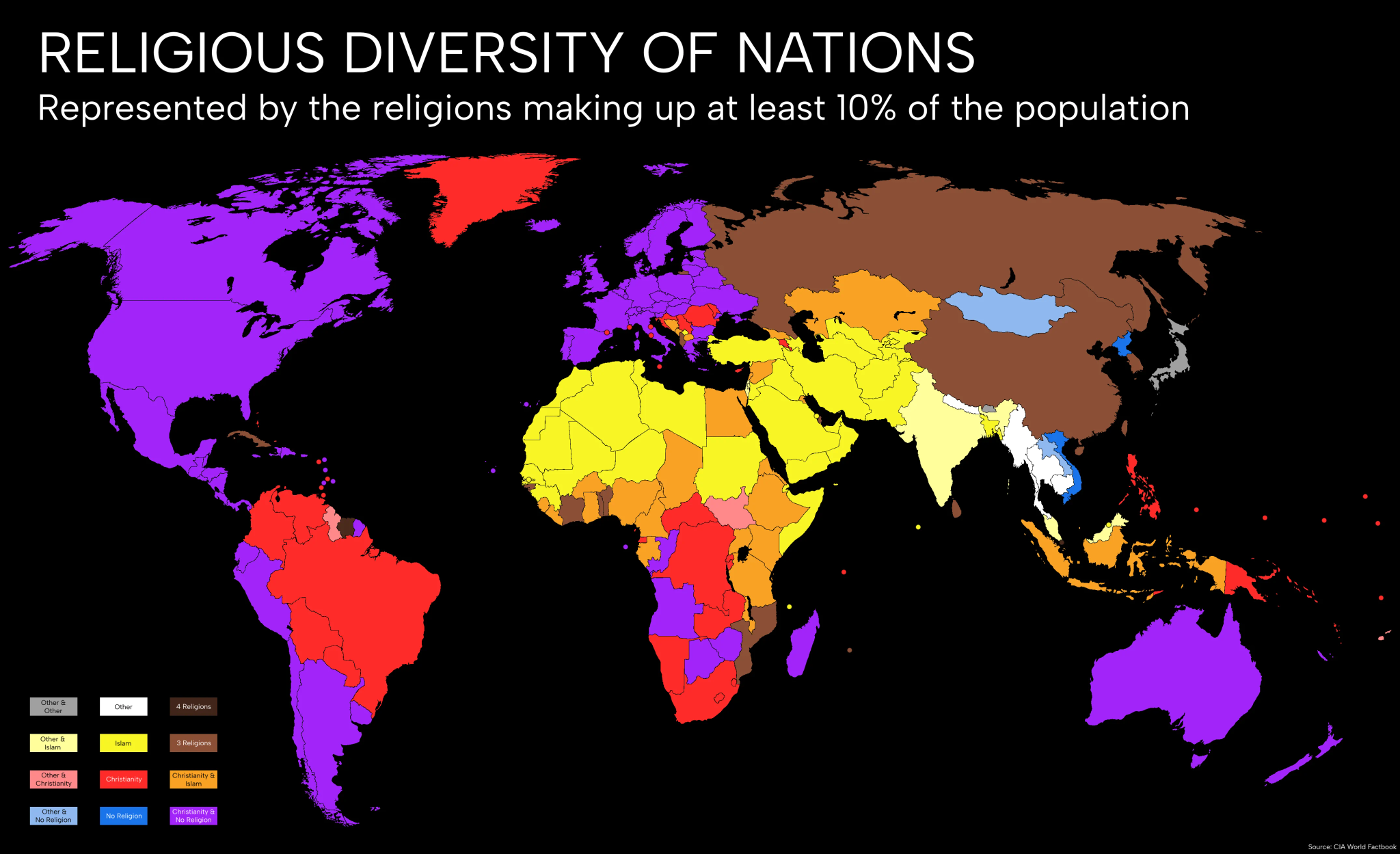🎅 🎄 🙏🏻✨ 🎄❄🎄 🎇☃️ 🎄 🎁 😊 🌟 🎆 🎆 🎇 🎅 🎄
Search This Blog
Tuesday, December 24, 2024
André Rieu 🙏🏻 Minuit Chrétien
🎅 🎄 🙏🏻✨ 🎄❄🎄 🎇☃️ 🎄 🎁 😊 🌟 🎆 🎆 🎇 🎅 🎄
Monday, December 16, 2024
Friday, December 13, 2024
Dance Act 🕺💃Greatest Audition on AGT


 🕺💃
🕺💃




Thursday, December 12, 2024
Global🌍Religious 🙏Diversity🌏




Of the 232 countries in the study, Singapore – an island nation of more than 5 million people situated at the southern tip of Malaysia – has the highest score on the Religious Diversity Index. About a third of Singapore’s population is Buddhist (34%), while 18% are Christian, 16% are religiously unaffiliated, 14% are Muslim, 5% are Hindu and <1% are Jewish. The remainder of the population belongs to folk or traditional religions (2%) or to other religions considered as a group (10%).
By contrast, France has a high degree of religious diversity, ranking 25th among the 232 countries. Christians make up 63% of France’s 2010 population, and two other groups account for sizable shares: the religiously unaffiliated (28%) and Muslims (8%). Iran, whose population is almost entirely Muslim, falls into the low diversity category.

http://en.wikipedia.org/wiki/Religions_by_country
Wednesday, December 11, 2024
How to Find 🎬 Great Films to Watch 👀

by Geoff Andrew
There is, and has always been, far more to the movies than action spectaculars, thrillers and feelgood romances. Not that there is necessarily anything wrong with such films – there are excellent, terrible and middling examples of every kind of movie – and we should never underestimate the appeal of escapism. Fantasy has been an important element of the cinematic offer ever since Georges Méliès delighted audiences with his trick films back in the late 1890s and early 1900s – and his influence lives on today. Méliès was referenced in Baz Luhrmann’s Moulin Rouge! (2001) and in Martin Scorsese’s Hugo (2011); his best-known film, the delightfully imaginative Le Voyage dans la Lune (1902), can be found on YouTube.
- Prepare to take a rewarding dive into the unknown. In the right hands, an artistic movie can touch us – emotionally and intellectually, culturally and philosophically.
- Start with an open mind. Before you embark on your journey beyond the mainstream, it’s important to set aside your preconceptions about any films with which you might not be familiar – such as foreign language, black-and-white, and ‘silent’ films.
- Give movies a chance. View your chosen film on a big screen if you can, and be patient – don’t expect to be hooked from the first minute.
- Get some advice. Don’t be afraid to ask for tips from film-buff friends, staff at independent cinemas, or cinephiles at your local theatre.
- Play to your strengths and interests. If there’s a contemporary genre you like, check out its history; if you have certain hobbies or countries you’re interested in, try exploring related movies.
- Follow your likes. If you particularly enjoy a movie, look for other films by the same director, featuring the same actor or from the same era or movement.
- Reflect on how films are made.
Film is an immensely rich, complex medium: at its best, it works on
several levels at once. The more you watch, the more you will come to
appreciate the collaborative artistry involved.
Films by pre-talkie filmmakers such as Abel Gance (Napoleon, 1927) and Sergei Eisenstein (Battleship Potemkin, 1925) used rapid editing or ‘montage’ to create excitement, particularly in dealing with conflict. Meanwhile, in movies such as Sabotage (1936), Rear Window (1954) and North by Northwest (1959), Hitchcock perfected a distinctive but highly flexible editing style that, in carefully concealing certain information from the viewer, not only created suspense but manipulated audience sympathies. Agnès Varda’s use of long takes in Cléo from 5 to 7 (1962) deftly tricks the viewer into thinking the naturalistic story is happening in real time, while the use of editing to create a fragmented, repetitive narrative rhythm in John Boorman’s Point Blank (1967) reflects the central character’s obsessive mindset.
Sound can be expressive too. Welles used all he’d learned working in radio when he made Citizen Kane, deploying echoes, volume changes and other effects to suggest the scale of rooms in which scenes take place, whereas Robert Bresson’s A Man Escaped (1956), about a prisoner of war, makes expert use of off-screen sounds to suggest activity in the world outside his cell. Bergman’s Persona deploys sound (and silence) to hint, subtly, that certain scenes may be dreamt or imagined, while David Lynch’s The Elephant Man (1980) and Blue Velvet (1986) are essentially expressionist in distorting and exaggerating sounds to create a sense of unease.
- Few serious magazines about the cinema survive in print in English but Sight and Sound, probably the best-known, is now available digitally too.
- The Australian website Senses of Cinema is an informative repository of director profiles and features.
- Just as you can find out which films and directors are rated highly by the critics and filmmakers who have voted every 10 years for Sight and Sound’s Greatest Films of All Time polls, it might also be worth checking which films were awarded top prizes by the juries at major film festivals, especially at Cannes and Venice. Many winners of the Palme d’Or and the Golden Lion went on to become major arthouse hits over the years.
- The history of cinema, if dealt with globally, is so huge and complex as to be beyond the scope of any one book. That said, Geoffrey Nowell-Smith’s The History of Cinema: A Very Short Introduction (2017) provides an outline of what has happened over the years.
- Another book The Story of Film (2nd ed, 2020) by Mark Cousins offers an alternative, occasionally provocative perspective on developments.
- Other books, along the lines of 1001 Movies You Must See Before You Die (updated ed, 2019), edited by Steven Jay Schneider, might prove a helpful starting point.
- The respected critic David Thomson has also written a number of books useful for further research, including The New Biographical Dictionary of Film (6th ed, 2014) and Have You Seen? (2008).
- The Aeon Video and Psyche Film channels feature many films that can complement your cinematic explorations, from an explainer about how film cuts work, to movie analysis from The Nerdwriter, and artistic experiments in the medium itself.
- Geoff Andrewis a critic, lecturer and programmer. He was for many years film editor of Time Out and head programmer at London’s BFI Southbank. He has written, edited and contributed to numerous books on film. He lives in London and writes on the arts at geoffandrew.com
👇
https://psyche.co/poiesis/creativity-and-the-arts/artists-and-art-history




.gif)
